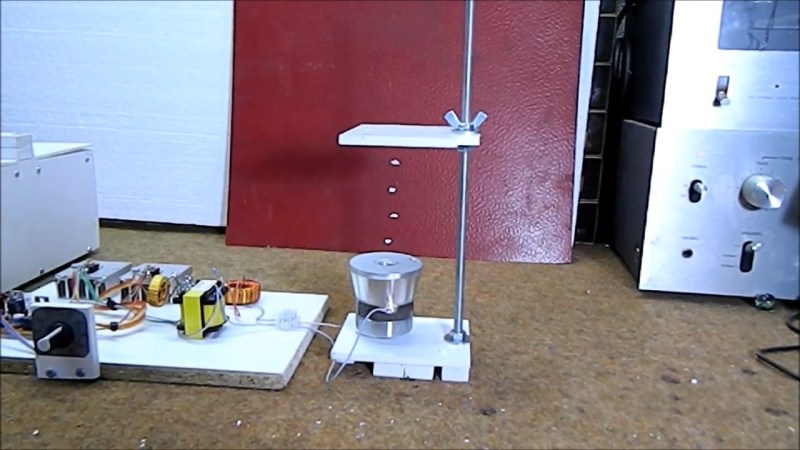Levitation may sound like magic, but there are a wide variety of physical phenomena that can be manipulated to generate the desired effect. In this case, [Mirko Pavleski] has built a rig capable of levitating small, lightweight particles through the use of ultrasound.
The rig uses a 60W ultrasonic transducer, operating at approximately 40 KHz, to generate a standing wave in combination with a reflector – essentially a rigid piece of material off which sound waves can be bounced. The interaction between the sound waves as they are emitted from the transducer and bounce off the reflector creates what is known as a standing wave, wherein there are areas of high and low amplitude that do not move in space. These areas correspond to the wavelength of the emission from the transducer, and allow lightweight pieces of styrofoam to be placed in to the low amplitude areas, where they are held in place by the wave.
It’s quite astounding the first time you see it in action, as the tiny particles appear to simply float in the air apropos of nothing. We’ve explored deeper applications of the technique before, too. Video after the break.
















” We’ve explored deeper applications of the technique before, too.”
Seem to remember speculation ages ago about that being how massive stones were moved. Of course this is the same age where pyramid power was a thing as well. Gotta keep those razor blades sharp.
Assuming reasonable sensitivity for the transducer, and some directionality arising from the surface under the transducer, 6W could easily exceed a 100dB SPL within a few feet of the levitation rig, with implications for temporary threshold shifts or inner ear injury.
caveat levitator!
Only very little of the power is converted into sound. The rest is dissipated internally in the transducer. Keep in mind that these transducers are meant to impart power to a metal container of water, and air is too light in weight to provide good power transfer from the transducer.
Wow – was it 7 years ago..?
https://www.youtube.com/watch?v=qy1w6rTpC2g
Dear [Mirko Pavleski], FYI the IR2153[1] self-oscillating 600V half-bridge gate driver IC is an ancient part and not recommended for any new designs. The Internet is rife with IR2153 clones from China. Long ago International Rectifier (bought out by Infineon in 2013) released the IRS2153D[2] as a pin-for-pin replacement for both the IR2153 and IR2153D. First came the IR2153D which replaced the sometimes cranky external bootstrap diode needed by the IR2153 with an on-die diode. Later the IRS2153D did away with the bootstrap diode entirely and replaced it with an on-die MOSFET switch controlled by an on-die Bootstrap Drive block.[3][4] Like the IR2153 and IRS2153D, the IRS2153D comes in a 8-PDIP or 8-SOIC package.
* References:
1. Original IR2153
https://www.infineon.com/cms/en/product/power/gate-driver-ics/ir2153/
2. Current IRS2153D
https://www.infineon.com/cms/en/product/power/gate-driver-ics/irs2153d/
3. IRS2153(1)D and IR2153(1)/IR2153(1)D Comparison
https://www.infineon.com/dgdl/Infineon-IRS2153D_and_IR2153_IR2153D_Comparison-AN-v01_00-EN.pdf?fileId=5546d462533600a4015355958ca11028
4. Bootstrap Network Analysis: Focusing on the Integrated Bootstrap Functionality
https://www.infineon.com/dgdl/Infineon-Bootstrap_Network_Analysis-ApplicationNotes-v01_00-EN.pdf?fileId=5546d462533600a40153559692661096
Thanks for detailed information
Ok, but this is nothing new or revolutionary. The first levitation was demonstrated by Bücks and Muller in 1933 who levitated alcohol droplets between a quartz crystal and a reflector. I just tried to describe an old and well-known experiment
In addition to being a cool proof of concept I’m really digging the *appearance* of the project, such as the on-a-piece-of-wood construction and the fact that you can see all the components and their connections. At first I thought “Okay, this is on the floor of someone’s room” then looked at the right side and realized I got the scale completely wrong.
I want to build sonar for an ROV. I’ve worked out the digital processing to find the echo, but my analog skills are weak. Is there a reference circuit I could use to drive these transducers?
Sonar Transducer switch.
http://www.next.gr/audio/ultrasonic-circuits/sonar-transducer-switch-l13837.html
Thank you!
I’d recommend checking some of these links
If I ever get around to it maybe use something like this for pick and place
https://www.youtube.com/watch?v=6YV0lou4L4c
https://www.instructables.com/Acoustic-Tractor-Beam/
https://github.com/Sophrinix/Acoustic-Tractor-Beam
https://github.com/asiermarzo/Ultraino
https://www.youtube.com/watch?v=h0Mh0bIv9Fk